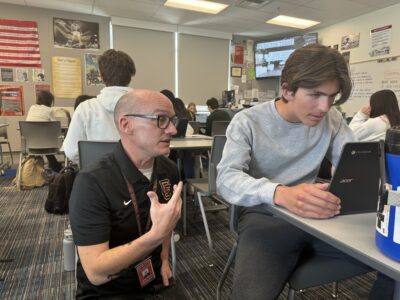Inside California Institute of the Arts’ (CalArts) Walt Disney Modular Theater, a student stands in the center of a whitewash set, picks up a vibrantly-colored robot and watches as a 360-degree video appears on the screen in front of him.
“I interviewed a few people about some clutter they have in their home and why they keep it,” said Trey Gilmore, a CalArts student who helped create the virtual reality (VR) project with seven other students. “Whenever you pick something up it moves and makes you see that video.”
Gilmore’s “In Defense of Clutter” was one of more than 300 projects on display at CalArts’ annual Digital Arts Expo, which displayed innovative works that integrated engineering and computer science with visual and performing arts.
The daylong expo united art, science and engineering and showcased exhibitions, performances and panel discussions from faculty, guest artists and technologists, and students of all disciplines. New technologies, prototypes and virtual environments were on display in nearly all corners of the institute.
“Every gallery is curated by a group of students. Students submit work from all over the school and curators fight over what they want in their space,” said Ajay Kapur, associate dean for research and development in digital arts and Digital Arts Expo director. “The staff are not involved… the students all bring it together.”
Kapur began the Digital Arts Expo six years ago as a “renegade show” in a CalArts hallway to showcase the work his students were doing in the classroom.
“It kept growing over the years,” he said. “This gives them a venue to showcase the work of all disciplines.”
The Expo also showcased how art-fueled technologies can move across disciplines, as artists collaborate with one another and look for new ways to approach art, communication, engineering and design.


“I feel like there are a lot of visual artists using audio and a lot of musicians using a lot of visuals. This year the theme is a lot of focus on VR,” Kapur said. “I personally teach mechatronics and that always blows my mind when students build their own robots.”
The Digital Arts Expo also gives students a chance to test their work as many as they move from the conceptual to the developmental and the operational stages.
“They [the pieces] vary from a first, technical step and then others might have mastered the technology to bring it beyond the first execution,” said Hillary Kapan, an experimental animation and integrated media teacher who teaches students how to create 360-degree environments in his classes.
The Expo included projects like “Sound Painting” where visitors could speak into a microphone as colorful circles and lines appeared on the screen, and a piece called “No Humans Allowed” where robotic figures created percussion music and flashed lights as visitors walked through the space.


According to Kapur, many of the projects on display were created by students in the classroom.
For example, the Machine Lab’s newest mechatronic wind instrument, the Windbot, was developed by an advanced class in the music technology program.
The newest addition to the KarmetiK Machine Orchestra, the Windbot blows air through a tube process and moves it through a pump to regulate the music it creates.
The mechatronic instrument required knowledge of electrical engineering, software engineering, mechanical design and composition, according to music technology: interaction, intelligence and design (MTIID) teacher Spencer Salazar.
“I help them combine a number of diverse skillsets to build the instruments,” he said.
The robotic orchestra then works together to interpret sheet music and produce music based on a pre-composed program.


The Expo also included personal VR projects that detailed the human experience with music and technology.
One of these projects was titled “Terra Incognita” and was directed and written by Ilana Kirschbaum, a student studying both film video and theater and experimental animation.
“Terra Incognita” included a VR installation, immersive sound and a puppet performance that details a real life event surrounding grief, adventure and human persistence.
“It’s based on a real life event. My father was a solo sailor and crossed the ocean on his own,” Kirschbaum said. “This piece deals with a father seeking himself on the ocean and then what happens when he disappears.”
In the same performance space was “Pippa’s Pan,” a collaborative virtual reality project that takes its viewers through the world of someone who has Alzheimer’s.
The project—which will be featured at this year’s Cannes Festival, Marche Du Film—takes viewers through the forest of Pippa’s mind as they are presented with objects and memories.
“It’s written from the patient’s perspective because we don’t know the environment of their mind or what they’re experiencing,” said Narae Kim, a CalArts MFA candidate in scenic design and animation who worked on the project. “In Pippa’s Pan we are trying to recapture our memory and are going into the mind and trying to release memories.”
By picking up objects or avoiding them altogether, viewers have a chance to choose what experience they have.
“It made me cry. It’s about an older woman who is losing her memory and her husband is trying to jog her memory,” said Cathy Akers, a professional artist and CalArts alumna who works in the school’s Advancement Office. “It’s beautiful and really moving.”
[email protected]
661-287-5575
On Twitter as @_ChristinaCox_








